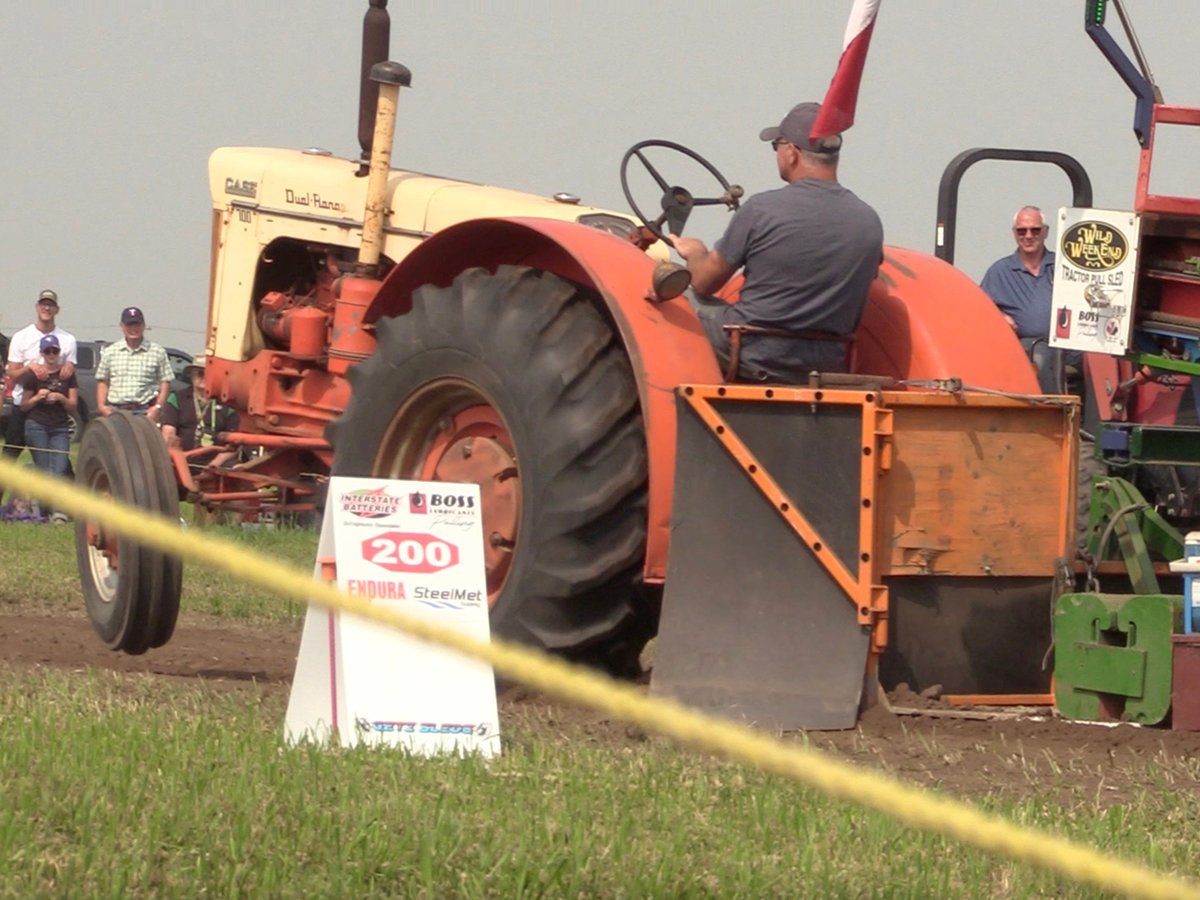It’s April and the snow is almost all gone in this area. We have had a spring shower already and the yard is starting to dry up. This means that all of us who love to garden are looking forward to the day when it is dry enough to get in the dirt.
Gardening is the second most popular physical activity in Canada, after walking. Thirty minutes of yard work such as planting or raking leaves can preserve flexibility, increase mobility and build strength and endurance. However, most of us tend to overdo it the first few times in the garden. Aches, pains, sprains and sometimes even a fracture can result from improper positioning of the body, overuse of certain muscle groups and pushing ourselves to work harder and longer than we should.
Read Also

Vintage power on display at Saskatchewan tractor pull
At the Ag in Motion farm show held earlier this year near Langham, Sask., a vintage tractor pull event drew pretty significant crowds of show goers, who were mostly farmers.
Here are a few tips from the Canadian Physiotherapy Association.
- Begin with a warmup. Go for a five minute walk or start with an easy task like gentle raking to warm up your muscles. Follow this with stretching all major muscle groups to prevent injury. Pay particular attention to back, neck, hands and fingers.
- Vary your tasks to make sure different muscles are used. Repetitive use of a specific muscle while gripping tools and digging in compacted soil can lead to strain injuries in the hands, wrists, arms and elbows. If you’re experiencing any twinges of pain, contact your doctor or a physiotherapist.
- Pace yourself. We tend to do everything all at once. Take breaks throughout your work and do some gentle stretching to keep limber.
- Be aware of your posture and body mechanics. Move your feet instead of twisting at your waist when sweeping, raking, mulching or potting. If you can’t avoid twisting, tighten your stomach muscles in order to protect your back.
- Use your legs rather than your back when lifting or unloading heavy bags or pots. Bend your knees, keep your back straight and hold the object close to your body.
- Buy weeding tools with long handles.
- Build or buy a potting bench that is high enough to prevent unnecessary bending.
- Sit on the ground to trowel without bending over. When kneeling, use a knee pad.
- Wear gardening gloves to protect your hands from blisters, cuts and dryness.
- Wear a hat and use sunscreen to protect from sunburn or heat stroke.
- Drink a glass of water before, during and after your stint in the garden. Try to work in the shade as much as possible.
- Reward your muscles with a hot bath.
For more wellness tips when gardening, go to www.producer.com and type “go for green” in the go box.
Collapsed bread
Dear TEAM: I’ve been baking bread, hand mixing, for 25 years with usually good results. Every so often my bread will rise beautifully, but as soon as I put it to bake it sits down. This happens more with whole wheat or multigrain bread. It doesn’t seem to matter if the oven is cold or preheated. I prefer slow yeast and a mix of about 60 percent whole wheat flour. The same bag of flour and the same can of yeast can produce both good or poor results. I let it rise once. If it rises twice, it seems to be worse. I’m out of ideas. What am I doing wrong? Ñ J.W., Tway, Sask.
Dear J.W.: There are a number of things that could be causing your bread loaf to collapse. I would suggest that you consider the following and rule out what doesn’t apply and you should have your answer.
- Bread dough can collapse if allowed to rise beyond the time called for in the recipe.
- The temperature may be too hot for the dough-rising period.
- There may have been too much liquid or yeast in the recipe.
- The ingredients aren’t measured accurately.
- Bring the yeast and flour to room temperature before using. If they are cold, the yeast will not work as well.
- Try using potato water because it helps the yeast grow.
- The salt should be mixed with the flour so it does not contact the yeast directly because it will affect the yeast growth.
- Try a bread flour that has been made from wheat that has a higher gluten content than all-purpose flour. The gluten is developed through kneading the dough. If the dough has not been kneaded long enough or if there is not enough gluten in the flour, there will not be enough strength in the dough to hold the yeast-created air bubbles.
If the gluten is weak, the loaf could collapse. You could add gluten powder to your existing flour. Add about one tablespoon (15 mL) of gluten powder to each cup (250 mL) of all-purpose flour used.
Katepwa buns
(or wheat berry buns)
I made these buns recently, and found that we really liked the taste and texture of the whole wheat berry in them.
1 cup clean wheat kernels 250 mL
1 cup lukewarm water 250 mL
2 teaspoons granulated sugar 10 mL
2 tablespoons granulated yeast 30 mL
2 eggs
1Ú3 cup granulated sugar 75 mL
1Ú3 cup canola oil 75 mL
2 cups warm water 500 mL
2 teaspoons salt 10 mL
2 cups cooked wheat 500 mL
4 cups all-purpose flour 1 L
1 tablespoon lemon juice 15 mL
5-6 cups all-purpose flour 1.25-1.5 L
One cup (250 mL) wheat kernels will yield three to four cups (750 mL-1 L) cooked wheat. Any extra not required for the bun recipe can be eaten as cereal or frozen for future use.
To make cooked wheat, measure wheat in a large ovenproof casserole. Cover with hot water and bake in a 350 F (180 C) oven for two to three hours.
Check regularly to add more hot water as the wheat expands. When done, the wheat will be soft and starting to crack.
In a two-cup (500 mL) measuring cup, combine the first three ingredients of water, sugar and yeast.
While the yeast is rising, using the large bowl of a Universal Kitchen machine, combine the eggs, the second amount of sugar, canola oil, warm water, salt, two cups (500 mL) of the cooked wheat, the first four cups of flour and lemon juice.
Once the yeast has risen, add it to the flour mixture. Always have the flour in the bowl before adding the risen yeast because the yeast needs the flour to act on. Beat with a dough hook to make a sponge dough. Let the sponge rise in the bowl until doubled in bulk about 30 minutes. Add remaining flour. The amount will depend on the total moisture that the cooked wheat has added to the recipe. Knead until soft and elastic. Let rise until doubled in bulk.
Punch down. Remove bread dough from the bowl, and cut the dough in half and the halves in half, until there are amounts that are easy to handle. Form dough into buns. Place on prepared baking sheets.
Let buns rise in a warm area until doubled in bulk. Fill a lasagna pan or roaster with hot tap water. Set one pan of buns on top of the pan. Cover with greased wax paper. This will keep the dough warm for rising.
Bake buns in a 350 F (180 C) oven for 15-20 minutes.
To retain that fresh-baked flavour, freeze buns in a large plastic bag as soon as they are cooled. Yields four dozen buns.
Source: Canola Cooks II, published by Canolainfo.
Household hints:
These cooking hints were sent in by two readers from Rama, Sask. When making French toast, use bread that is at least one day old. If the bread is too fresh, it will lose its shape and absorb too much of the liquid.
When using frozen fish, let the fish thaw in milk. The milk removes that frozen taste and keeps fish moist.
Betty Ann Deobald is a home economist from Rosetown, Sask., and one of four columnists comprising Team Resources. Send correspondence in care of this newspaper, Box 2500, Saskatoon, Sask., S7K 2C4 or contact them at team@producer.com.
















